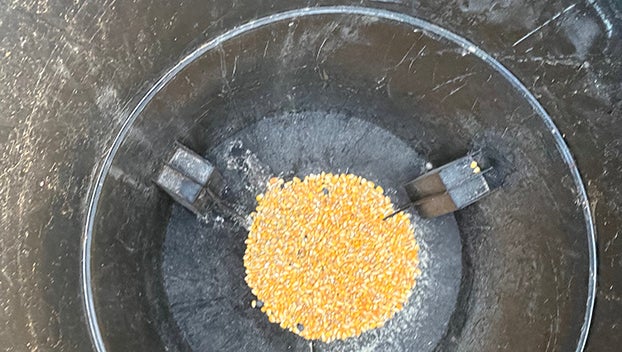Mississippi saw record CWD samples in FY2024, feed ban discussion starts Thursday
Published 11:17 am Wednesday, March 20, 2024

- A small amount of corn left in a feeder in Lincoln County. Proper habitat management is more cost effective than filling a feeder and can help increase daytime deer movement. (Hunter Cloud | The Daily Leader)
JACKSON — Mississippi hunters submitted 8,843 samples, a record high, for Chronic Wasting Disease this year with 110 positives detected, a record. It is safe to say the sampling season is likely over with no more open hunting seasons although some roadkill samples may stream in over the offseason.
Chronic Wasting Disease is a 100 percent, always fatal disease caused by an infectious prion, or misfolded protein. Prions are shed in bodily fluids and ingested by deer in some form or fashion such as eating or licking. Prions go to the spleen first and then infect the lymph nodes next where it collects.
According to MDWFP, deer can not test positive until six months after it becomes infected. Prions cause the nervous system tissues to form holes. CWD can be in deer up until 18 months after infection before deer start to show symptoms.
Mississippi positives are mostly from deer who have yet to show symptoms. A contrast to neighboring Louisiana where seven out of the 21 CWD positive detections were clinical, or symptomatic, deer.
Some hunters have claimed the CWD positives are up due to more sampling. MDWFP’s CWD Dashboard shows hunters turned in 8,024 samples in 2019, 8,514 samples in 2020, 7,312 samples in 2021, 7,106 samples in 2022 and 7,915 samples in 2023. Positive detections in 2019 was 18, 35 in 2020, 28 in 2021, 45 in 2022 and 187 in 2023.
It is important to note the 110 positives were detected in the fiscal year, July 1 to June 30, by MDWFP while the numbers listed by year are under the calendar year.
Feed bans
One of the more controversial aspects of Chronic Wasting Disease is the required change in hunter behavior. Supplemental feeding used to be part of quality deer management. The disease risks associated with Chronic Wasting Disease as shown in research conducted by Mississippi State University Deer lab mean feed bans are a tool to help keep disease prevalence down.
MDWFP Deer Program Coordinator William McKinley said researchers with Mississippi State University flew transects across the state and estimated there are 118,000 deer feeders on the landscape during a radio interview on SuperTalk Outdoors Monday. Using the current estimated deer population, that is one feeder for every 13 deer.
MDWFP Commissioners and the public have a chance to hear a report about supplemental feeding as it relates to disease management Thursday morning at Percy Quin State Park. Commissioners meet once a month and will hear the report during an educational session starting at 9 a.m. followed by a business session at 10 a.m.
The Daily Leader will have stories from the commission meeting business and educational session so check back for updates.
Why is CWD a concern?
Research has continually shown that CWD facilitates, promotes and accelerates death of white-tailed deer.
A few projects presented at the Southeastern Deer Study Group in February looked at the relationship of Chronic Wasting Disease with deer. One of those was an ongoing project looking at fawn recruitment in northwest Arkansas conducted by the University of Georgia Deer Lab.
Preliminary research shows the CWD status of does did not significantly impact fawn survival. Fawns of CWD positive does had 49 percent survival while fawns of does without CWD had 33 percent survival. Average survival rates of fawns to 180 days was 39 percent which is comparable to the rest of the southeastern United States.
Doe health, fawn weight, twin presence and distance to field were positively associated with survival. The project stated the results were conditional on does being healthy enough to give birth.
The paper raised questions about the impacts of CWD on fecundity, or the ability to reproduce, which would be addressed by assessing the effects on pregnancy and partition rates, or fawn birth. The paper states the reproductive output could be limited due to a decrease in longevity even if there are no effects on survival or fecundity of fawns.
West Virginia has research showing that Chronic Wasting Disease is the leading cause of death in a high CWD prevalent county while hunters lead mortality rates in other counties. Arkansas has similar research about CWD being the leading cause of mortality of positive deer.
At this time, it is unknown if CWD is a threat to humans but there is concern of zoonotic spread. The Center of Disease Control recommends humans do not consume the meat of CWD positive animals.





